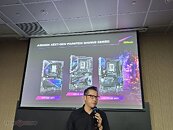- Joined
- Oct 9, 2007
- Messages
- 47,895 (7.37/day)
- Location
- Dublin, Ireland
| System Name | RBMK-1000 |
|---|---|
| Processor | AMD Ryzen 7 5700G |
| Motherboard | Gigabyte B550 AORUS Elite V2 |
| Cooling | DeepCool Gammax L240 V2 |
| Memory | 2x 16GB DDR4-3200 |
| Video Card(s) | Galax RTX 4070 Ti EX |
| Storage | Samsung 990 1TB |
| Display(s) | BenQ 1440p 60 Hz 27-inch |
| Case | Corsair Carbide 100R |
| Audio Device(s) | ASUS SupremeFX S1220A |
| Power Supply | Cooler Master MWE Gold 650W |
| Mouse | ASUS ROG Strix Impact |
| Keyboard | Gamdias Hermes E2 |
| Software | Windows 11 Pro |
ASRock at the 2024 Computex presented a massive lineup of gaming and overclocking motherboards based on the Intel Z890 chipset. The company is not allowed to use the term "Z890," and refers to it as "next-gen Intel," but for convenience's sake, we will use Z890 in this article. Z890 is the highest tier desktop chipset for Socket LGA1851, which will power the Core Ultra "Arrow Lake-S" desktop processors that launch in Q4 2024. With the Z890 generation, ASRock stratified its coveted Taichi brand of high-end motherboards further up, clubbing its enthusiast-grade OC Formula brand along with it.
There are now Taichi OCF motherboards with either 1-DIMM per channel memory configurations (best dual-channel topology for memory overclocking), or with a new CAMM2 slot. There's also a mainline Taichi Lite, which is a no-frills variant with less bling, and essential high-end features such as a strong VRM and good onboard audio; and there's also the new Taichi Aqua, targeting the creator crowd, with its liquid-cooled VRM+SSD heatsink setup.






We begin our tour with the Z890 Taichi Aqua. This board has three striking features. First, is its white PCB, which should pair well with your white graphics card. Second, is its liquid-cooled heatsink array, which cools the CPU VRM and the topmost M.2-2280 Gen 5 slot that's wired to the CPU. There's enough finnage to liquid-cool the VRM and a feisty Gen 5 NVMe SSD. And third, is the all type-C USB setup. That's right, this board completely does away with all type-A USB ports. If you want them, there are a bunch of USB 3.2 and USB 2.0 headers. Two of these type-C ports are 40 Gbps Thunderbolt 4, which include DisplayPort wiring from the iGPU.




Next up, is the Z890 Taichi OCF (OC Formula). This board is geared toward record-setting overclocking, and is from the same category as the GIGABYTE AORUS Tachyon, and ASUS ROG Maximus Apex. Besides an overpowered CPU VRM and a boatload of features relevant to professional overclockers, this board has a 1-DIMM per channel memory configuration that provides the best memory overclocking headroom. There are quite a few enthusiasts who just want the pesky memory out of the way and focus on CPU overclocking. For this exact niche, ASRock developed a variant of the Z890 Taichi OCF with a DDR5 CAMM2 slot.
Next up is the Z890 Taichi, the OG model in the series, which strikes a balance between overclocking capabilities, connectivity, and other premium features, for a high-end desktop build. If you can do without the elaborate heatsinks, RGB blink, but just want the basic high-end stuff in the series, such as a good CPU VRM, a high-end onboard audio, and more, there's the Z890 Taichi Lite.
Next up, is the Z890 Phantom Gaming series. There will be many boards in this series, but at launch, there will be the Z890 Phantom Gaming NOVA, a fairly feature-packed board with plenty of heatsinks, M.2 NVMe slots, and premium onboard audio. The Z890 Phantom Gaming Riptide is a notch below the NOVA, with a fairly good feature-set. At the value end of the series is the Z890 Phantom Gaming Lightning WiFi. The Z890 Steel Legend and PRO series forms the mainstream in ASRock's lineup, and there are two variants here, the Z890 Steel Legend, and the PRO Z890 RS.
View at TechPowerUp Main Site
There are now Taichi OCF motherboards with either 1-DIMM per channel memory configurations (best dual-channel topology for memory overclocking), or with a new CAMM2 slot. There's also a mainline Taichi Lite, which is a no-frills variant with less bling, and essential high-end features such as a strong VRM and good onboard audio; and there's also the new Taichi Aqua, targeting the creator crowd, with its liquid-cooled VRM+SSD heatsink setup.






We begin our tour with the Z890 Taichi Aqua. This board has three striking features. First, is its white PCB, which should pair well with your white graphics card. Second, is its liquid-cooled heatsink array, which cools the CPU VRM and the topmost M.2-2280 Gen 5 slot that's wired to the CPU. There's enough finnage to liquid-cool the VRM and a feisty Gen 5 NVMe SSD. And third, is the all type-C USB setup. That's right, this board completely does away with all type-A USB ports. If you want them, there are a bunch of USB 3.2 and USB 2.0 headers. Two of these type-C ports are 40 Gbps Thunderbolt 4, which include DisplayPort wiring from the iGPU.




Next up, is the Z890 Taichi OCF (OC Formula). This board is geared toward record-setting overclocking, and is from the same category as the GIGABYTE AORUS Tachyon, and ASUS ROG Maximus Apex. Besides an overpowered CPU VRM and a boatload of features relevant to professional overclockers, this board has a 1-DIMM per channel memory configuration that provides the best memory overclocking headroom. There are quite a few enthusiasts who just want the pesky memory out of the way and focus on CPU overclocking. For this exact niche, ASRock developed a variant of the Z890 Taichi OCF with a DDR5 CAMM2 slot.
Next up is the Z890 Taichi, the OG model in the series, which strikes a balance between overclocking capabilities, connectivity, and other premium features, for a high-end desktop build. If you can do without the elaborate heatsinks, RGB blink, but just want the basic high-end stuff in the series, such as a good CPU VRM, a high-end onboard audio, and more, there's the Z890 Taichi Lite.
Next up, is the Z890 Phantom Gaming series. There will be many boards in this series, but at launch, there will be the Z890 Phantom Gaming NOVA, a fairly feature-packed board with plenty of heatsinks, M.2 NVMe slots, and premium onboard audio. The Z890 Phantom Gaming Riptide is a notch below the NOVA, with a fairly good feature-set. At the value end of the series is the Z890 Phantom Gaming Lightning WiFi. The Z890 Steel Legend and PRO series forms the mainstream in ASRock's lineup, and there are two variants here, the Z890 Steel Legend, and the PRO Z890 RS.
View at TechPowerUp Main Site






